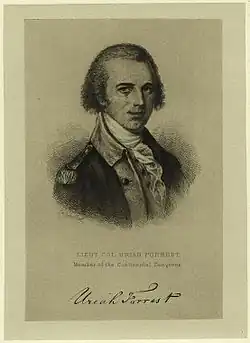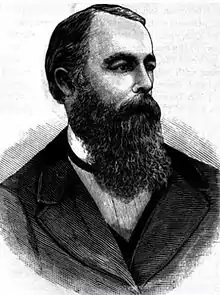Maryland's 3rd congressional district
Maryland's 3rd congressional district comprises all of Howard county as well as parts of Anne Arundel and Carroll counties. The seat is currently represented by John Sarbanes, a Democrat.
| Maryland's 3rd congressional district | |||
|---|---|---|---|
Interactive map of district boundaries since January 3, 2023 | |||
| Representative |
| ||
| Area | 292.74 sq mi (758.2 km2) | ||
| Distribution |
| ||
| Population (2022) | 777,611 | ||
| Median household income | $119,418[1] | ||
| Ethnicity |
| ||
| Occupation |
| ||
| Cook PVI | D+10[2] | ||
Three people who represented Maryland in the United States Senate were also former representatives of the 3rd district, including Ben Cardin, Barbara Mikulski, and Paul Sarbanes.
The district's previously odd shape was attributed to gerrymandering to favor Democratic candidates, following the 2000[3] and 2010[4] censuses. In 2012, the district was found to be the third least compact congressional district in the United States,[5] and in 2014, The Washington Post called it the nation's second-most gerrymandered district.[6] John Sarbanes, the current Democratic Representative for the district, put forth the For the People Act of 2019 to address electoral reform, voting rights, and gerrymandering in the United States.[7][8] Following the 2020 redistricting cycle, it now comprises Howard County, most of Anne Arundel County including Glen Burnie and Annapolis, and part of Carroll County, specifically the areas around Mount Airy, and its incumbent representative John Sarbanes no longer lives in the district.
Recent statewide election results
| Year | Results |
|---|---|
| 2000 | Gore 55% – 41% |
| 2004 | Kerry 54% – 45% |
| 2008 | Obama 59% – 39% |
| 2012 | Obama 60% – 37% |
| 2016 | Clinton 62% – 32% |
| 2020 | Biden 69% – 29% |
Historical boundaries
Maryland's 3rd district was one of the 61 districts that elected a representative to the 1st United States Congress. It also has the distinction of being one of the few congressional districts that once included areas not currently in the state they are in. The 3rd congressional district originally was composed of Prince George's County, Maryland and Anne Arundel County, Maryland.[9] At that point, what is now Howard County, Maryland, was in Anne Arundel County, and Prince George's County included the eastern half of the District of Columbia.
In 1792, the Maryland 3rd Congressional District was moved to include Montgomery County, Maryland, and the eastern half of Frederick County, Maryland. The population was about 33,000.[10] However, the western portion of what is today Carroll County, Maryland was at this point in Frederick County, and the western half of the District of Columbia was in Montgomery County. This latter fact explains why the district lost population, even though it, in theory, did not experience redistricting after the 1800 census. With the population of Georgetown, D. C., no longer in the district, its 1800 population was about 31,000.[11] At this point, the 3rd was Maryland's least populous district, barely having half the population of the Baltimore City and County 5th district, which, in 1800, had just above 59,000 inhabitants.[12]
The boundaries remained the same after the 1810, 1820, and 1830 censuses. While, in 1820, the district had about 36,000 inhabitants, its population had risen to 53,622 in 1830.[13] With the formation of Carroll County in the 1830s, as well as Maryland falling from 8 to 6 congressional seats, the boundaries of the 3rd Congressional District were drastically redrawn. The only area that remained in the 3rd Congressional District was the part of Carroll County that had been in Frederick County. The 3rd also included Baltimore County and the western half of the city of Baltimore. Its new population was 69,923, 24.5% of whom were black.[14]
In 1853, the 3rd district was redrawn again. The new district consisted of Baltimore County, except for the northern and western parts of the county and about the eastern third of the City of Baltimore. The district now had a population of 95,729.[15] In the redistricting following the 1860 census, Maryland was reduced to five congressional districts. The 3rd was moved so that it contained the part of Baltimore that had not been in the 3rd before 1863. It now had a population of 130,040.[16] In 1873, the 3rd district was moved again, to be the east side of Baltimore. It now had a population of 120,978.[17]
Recent elections
2000s
| Party | Candidate | Votes | % | |
|---|---|---|---|---|
| Democratic | Benjamin Cardin (Incumbent) | 169,347 | 75.66 | |
| Republican | Scott Conwell | 53,827 | 24.05 | |
| Libertarian | Joe Pomykala | 238 | 0.11 | |
| Write-ins | 406 | 0.18 | ||
| Total votes | 223,818 | 100.00 | ||
| Democratic hold | ||||
| Party | Candidate | Votes | % | |
|---|---|---|---|---|
| Democratic | Benjamin Cardin (Incumbent) | 145,589 | 65.79 | |
| Republican | Scott Conwell | 75,721 | 34.21 | |
| Total votes | 221,310 | 100.00 | ||
| Democratic hold | ||||
| Party | Candidate | Votes | % | ±% | |
|---|---|---|---|---|---|
| Democratic | Benjamin Cardin (Incumbent) | 182,066 | 63.44% | -2.35 | |
| Republican | Robert P. Duckworth | 97,008 | 33.80% | -0.41 | |
| Green | Patsy Allen | 7,895 | 2.75% | +2.75 | |
| Total votes | 286,969 | 100.00 | |||
| Democratic hold | |||||
| Party | Candidate | Votes | % | ±% | |
|---|---|---|---|---|---|
| Democratic | John Sarbanes | 150,142 | 64.03% | +0.59 | |
| Republican | John White | 79,174 | 33.76% | -0.04 | |
| Libertarian | Charles Curtis McPeek, Sr. | 4,941 | 2.11% | +2.11 | |
| Write-ins | 229 | 0.10% | +0.10 | ||
| Total votes | 234,486 | 100.00 | |||
| Democratic hold | |||||
| Party | Candidate | Votes | % | ±% | |
|---|---|---|---|---|---|
| Democratic | John Sarbanes (Incumbent) | 203,711 | 69.66% | +5.63 | |
| Republican | Thomas E. Harris | 87,971 | 30.08% | -3.68 | |
| No party | Write-ins | 766 | 0.26 | ||
| Total votes | 292,448 | 100.00 | |||
| Democratic hold | Swing | ||||
2010s
| Party | Candidate | Votes | % | ±% | |
|---|---|---|---|---|---|
| Democratic | John Sarbanes (Incumbent) | 147,448 | 61.07% | -8.59 | |
| Republican | Jim Wilhelm | 86,947 | 36.01% | +5.93 | |
| Libertarian | Jerry McKinley | 5,212 | 2.16% | +2.16 | |
| Constitution | Alain Lareau | 1,634 | 0.68% | +0.68 | |
| No party | Write-ins | 188 | 0.1% | ||
| Total votes | 241,429 | 100.00 | |||
| Democratic hold | |||||
| Party | Candidate | Votes | % | |
|---|---|---|---|---|
| Democratic | John Sarbanes (Incumbent) | 213,747 | 66.8 | |
| Republican | Eric Delano Knowles | 94,549 | 29.6 | |
| Libertarian | Paul R. Drgos, Jr. | 11,028 | 3.4 | |
| N/A | Others (write-in) | 535 | 0.2 | |
| Total votes | 319,859 | 100 | ||
| Party | Candidate | Votes | % | |
|---|---|---|---|---|
| Democratic | John Sarbanes (incumbent) | 128,594 | 59.6 | |
| Republican | Charles A. Long | 87,029 | 40.3 | |
| n/a | Write-ins | 323 | 0.1 | |
| Total votes | 215,946 | 100.0 | ||
| Democratic hold | ||||
| Party | Candidate | Votes | % | |
|---|---|---|---|---|
| Democratic | John Sarbanes (incumbent) | 214,640 | 63.2 | |
| Republican | Mark Plaster | 115,048 | 33.9 | |
| Green | Nnabu Eze | 9,461 | 2.8 | |
| n/a | Write-ins | 526 | 0.1 | |
| Total votes | 339,675 | 100.0 | ||
| Democratic hold | ||||
| Party | Candidate | Votes | % | |
|---|---|---|---|---|
| Democratic | John Sarbanes (incumbent) | 202,407 | 69.1 | |
| Republican | Charles Anthony | 82,774 | 28.3 | |
| Libertarian | J. David Lashar | 7,476 | 2.6 | |
| n/a | Write-ins | 223 | 0.1 | |
| Total votes | 292,880 | 100.0 | ||
| Democratic hold | ||||
2020s
| Party | Candidate | Votes | % | |
|---|---|---|---|---|
| Democratic | John Sarbanes (incumbent) | 260,358 | 69.8 | |
| Republican | Charles Anthony | 112,117 | 30.0 | |
| Write-in | 731 | 0.2 | ||
| Total votes | 373,206 | 100.0 | ||
| Democratic hold | ||||
| Party | Candidate | Votes | % | |
|---|---|---|---|---|
| Democratic | John Sarbanes (incumbent) | 175,514 | 60.2 | |
| Republican | Yuripzy Morgan | 115,801 | 39.7 | |
| Write-in | 287 | 0.1 | ||
| Total votes | 291,602 | 100.0 | ||
| Democratic hold | ||||
List of members representing the district
See also
Notes
- Supported the Adams-Clay faction in the 1824 United States presidential election
References
- "My Congressional District".
- "2022 Cook PVI: District Map and List". The Cook Political Report. July 12, 2022. Retrieved October 8, 2022.
- "Politics Makes Strange Bedfellows, Even Stranger Congressional Boundaries". Maryland Newsline, University of Maryland. February 20, 2004. Archived from the original on March 8, 2019. Retrieved May 6, 2007.
- "Maryland Redistricting Plan Advances". The Washington Post. October 17, 2011.
- Lazarick, Len (October 3, 2012). "Maryland has least compact congressional districts in nation". MarylandReporter.com. Retrieved October 7, 2012.
- Ingraham, Christopher (May 15, 2014). "America's most gerrymandered congressional districts". The Washington Post. Retrieved August 7, 2016.
- Sarbanes, John (January 3, 2019). "H.R.1 - 116th Congress (2019-2020): To expand Americans' access to the ballot box, reduce the influence of big money in politics, and strengthen ethics rules for public servants, and for other purposes". www.congress.gov. Archived from the original on January 7, 2019. Retrieved January 6, 2019.
- 116th Congress (2019) (January 3, 2019). "H.R. 1 (116th)". Legislation. GovTrack.us. Retrieved March 7, 2019.
For the People Act of 2019
- Parson, Stanley B., William W. Beach, and Dan Hermann. United States Congressional Districts, 1788–1841 (Westport: Greenwood Press, 1978) p. 8-9
- Parsons. Congressional Districts. p. 42-43
- Parsons. Congressional Districts. p. 93-94
- Parsons. Congressional Districts. p. 94
- Parsons. Congressional Districts p. 234, 318
- Parson, Stanley B., William W. Beach, and Michael J. Durbin. United States Congressional Districts, 1843–1883 (Westport: Greenwood Press, 1986) p. 16
- Parsons. Con. Dis. 1843–1883 p. 64
- Parsons. Con. Dis. 1843–1883 p. 115
- Parsons. Con. Dis. 1843–1883 p. 177
- "Unofficial 2012 Presidential General Election results for Representative in Congress". Maryland State Board of Elections. Retrieved November 12, 2012.
- "Official 2016 Presidential General Election results for Representative in Congress". Maryland Secretary of State. Retrieved December 9, 2016.
- "Official 2020 Presidential General Election results for Representative in Congress". Maryland State Board of Elections. Retrieved December 14, 2020.
.svg.png.webp)

.jpg.webp)



.jpg.webp)


.jpg.webp)

.jpg.webp)









.jpg.webp)

.jpg.webp)

.jpg.webp)

.jpg.webp)








.tif.png.webp)
.svg.png.webp)